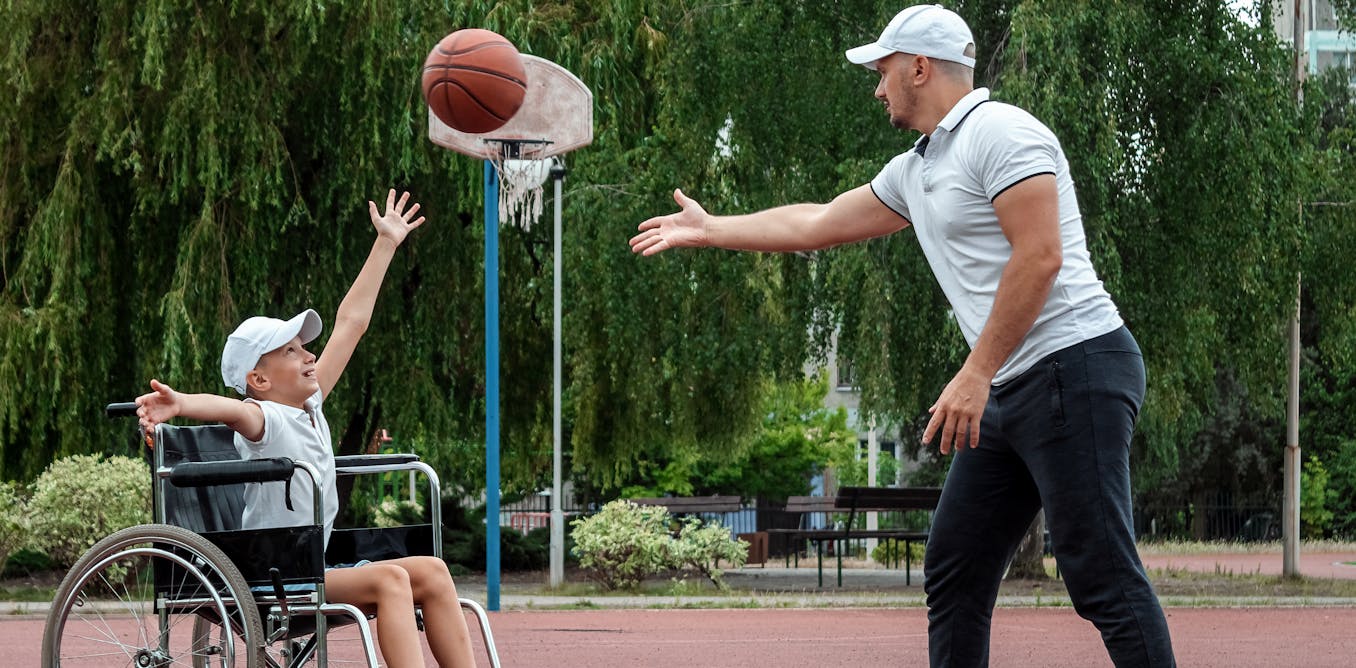Black and Latino students get suspended more for missing school

GLENDALE, Ariz. — Camron Olivas has been suspended at least five times throughout middle and high school for being late to class. While his mother cares for his toddler sister, his older brother drives him in, and they frequently arrive after the first bell. During the day, Camron said he sometimes remains in the hallways too long between classes, talking to his friends.
Punishments for the teen’s tardiness have escalated from warnings to in-school suspensions to multiday out-of-school suspensions.
Camron, 15, attends Deer Valley High School, just west of Phoenix, where he is one of an outsize number of Hispanic students who have been suspended for attendance violations, according to district data. Camron, who is also Native American, most recently spent a day in the in-school suspension room in October, a punishment that forced him to miss seven whole periods for occasionally being a few minutes late to some of them. The next day, he had to catch up on what he missed, while also taking in new lessons.
“I never thought it made sense,” Camron said of the punishment.
Students all over Arizona are suspended for not showing up to class, whether it’s because they arrive late, leave campus midday or fail to make it at all, an investigation by The Hechinger Report and the Arizona Center for Investigative Reporting has found. And, the data shows, Black, Latino and Native American students are frequently overrepresented among those blocked from class for missing class — what some argue is evidence of a potential civil rights violation.
Nationally, researchers have tied similar discipline disparities to school attendance policies and the unequal application of punishment. The policies tend to be more accepting of reasons that white students are most likely to miss class, and educators unevenly assign discipline of all kinds, allowing bias to creep in. The consequences can be steep: These inequities in school discipline — what some researchers have dubbed the “punishment gap” — contribute directly to racial differences in academic performance.
“Students have a right to be treated in equity with their peers, and when there’s unexplained disproportionality, it’s really incumbent on schools to understand why that disproportionality exists and to work to rectify it,” said Darrell Hill, attorney and policy director for the American Civil Liberties Union of Arizona.
Related: When the punishment is the same as the crime: Suspended for missing class
Students from historically marginalized groups who receive excessive suspensions in response to tardies or unexcused absences could “certainly” have grounds for a civil rights claim, Hill said.
The Hechinger/AZCIR investigation offers one of the most in-depth analyses ever conducted of suspensions for attendance violations. Because most states and the federal government don’t collect detailed data on the reasons behind suspensions, the extent of this controversial practice has long remained hidden.
The analysis revealed nearly 47,000 suspensions for attendance violations over the past five school years, across more than 80 districts that suspended students for missing class. The true scale of the problem is likely much larger, as almost 250 districts failed to provide comprehensive data in response to public records requests.
“You’re going to suspend me for being late, and then you’re going to make me fall behind in class more. It’s like, what was the point?”
DaMarion Green, Dysart High School student
Cumulatively, Black and Hispanic students were overrepresented among those punished every year, among 20 districts that supplied usable demographic data. (Together, they accounted for 90 percent of all attendance-related suspensions in the sample.) Last school year, for example, Black students made up 6 percent of the total enrollment across all 20 districts but received 15 percent of suspensions. Hispanic students made up 43 percent of enrollment but received 68 percent of suspensions.
White students, meanwhile, were largely underrepresented, making up 37 percent of enrollment and receiving 23 percent of suspensions.
Among the dozen districts with enough data to assess Native American student representation, these students sometimes accounted for double or triple the share of suspensions that would be expected based on their proportion of enrollment.
Presented with the results of the analysis, Kathy Hoffman, Arizona superintendent of public instruction, issued a statement saying the findings confirmed “why it is vital for Arizona to focus on equitable and fair treatment of all students.” But she did not address the state’s role during her four-year tenure, instead urging her recently elected successor to “work with our schools toward solutions that uplift and support students of color in Arizona” once he is sworn in.
“When students of color are disproportionately disciplined, it impacts the time they can spend learning in the classroom and hampers their ability to succeed academically,” Hoffman said.
Under the Obama administration, the U.S. departments of Justice and Education issued joint guidance to schools about racial disparities in school discipline. They cautioned that a disciplinary policy that had an adverse impact on students of a particular race and was “not necessary to meet an important educational goal” violated civil rights law.
The agencies highlighted out-of-school suspensions for missing school as cause for particular concern.
“A school,” the guidance read, “would likely have difficulty demonstrating that excluding a student from attending school in response to the student’s efforts to avoid school was necessary to meet an important educational goal.”
Related: Inside our analysis of attendance-related suspensions in Arizona
The Trump administration rescinded the guidance in 2018, saying it went beyond what the Civil Rights Act required. But the departments asserted that “robust protections against race, color, and national origin discrimination … remain unchanged.”
Under the Biden administration, the U.S. Department of Education’s Office for Civil Rights has yet to issue fresh guidance on the topic. But Assistant Secretary Catherine Lhamon, who first ran the office under former President Barack Obama, said her staff would use the same process it used then to assess whether disparities in discipline constitute unlawful discrimination.
“It’s kind of just how they see you. If you hang out with certain kids, it happens a lot. Especially for being late.”
Antoine Moore, Deer Valley High School student
The Office for Civil Rights considers more than just data when deciding whether or not discrimination occurred. But Lhamon said the numbers uncovered by the Hechinger/AZCIR analysis offer justification for an investigation. “Disparities of any kind are notable and worth evaluating,” Lhamon said.
“I am very concerned when I hear about kids missing instructional time,” she added.
In some Arizona districts, the imbalance in who gets suspended for attendance violations is striking.
Glendale Union High School District, for example, handed out nearly 12,500 suspensions for attendance violations over the past five school years. And while Latino students made up about 60 percent of its enrollment, they accounted for up to 90 percent of students suspended. Black students represented about 8 percent of students enrolled but as much as 21 percent of students suspended, while Native American students made up about 2 percent of enrollment and as much as 6 percent of suspensions.
Kim Mesquita, Glendale Union High School District spokeswoman, did not comment on the disparities in school discipline by race. In response to questions about the district’s frequent use of suspensions for attendance violations, she said the district was “reviewing the data” and “determining what is effective and what is not.”
Related: Some kids have returned to in-person learning only to be kicked right back out
Researchers have found that racial disparities in who is disciplined for absenteeism can be attributed, in part, to attendance policies themselves. School districts punish students only for unexcused absences, making district approval for missing school crucial. And white students are more likely than those of other races to be absent for reasons that schools excuse.
“Racism is so blatantly written into the policies,” said Clea McNeely, a University of Tennessee research professor who studied attendance policies in a nationally representative sample of 97 school districts.
McNeely and her team found that school districts were less likely to excuse absences caused by life circumstances more typically experienced by Black, Hispanic and American Indian children.
Students who go to the doctor when they’re sick have an easier time getting illness-related absences excused, for instance, and white families are more likely to receive medical care. Kids whose families can’t afford reliable transportation are more likely to rack up tardies that lead to suspensions. Schools will often excuse an absence for a child visiting a parent in the military, but not one for visiting a parent who is incarcerated. The list goes on. Centuries of discrimination, sometimes government-sponsored, have led to racial patterns around poverty and incarceration, making Black, Latino and Indigenous families less likely to be insured, more likely to live in poverty, and more likely to deal with incarceration.
Across three districts where McNeely’s team studied individual absences, 13 percent of white students’ absences were deemed unexcused, compared with 21 percent of absences by Hispanic students and 24 percent of absences by Black and American Indian students.
Arizona districts have policies similar to those McNeely studied. In Dysart Unified School District, for example, illness, medical appointments and approved family vacations are among the reasons students can qualify for an excused absence.
Black students make up about 7 percent of Dysart’s enrollment, yet they received as much as 13 percent of suspensions over the past five school years. Hispanic students make up around 40 percent of enrollment and received as much as 67 percent of suspensions.
In one study, absences among Black students were unexcused 24 percent of the time, compared with 13 percent for white students.
Renee Ryon, spokeswoman for Dysart Unified, said discipline for attendance violations is clearly described in the student handbook.
“Either students come to class on time, or they are marked tardy or absent,” Ryon said via email. “Dysart is dedicated to serving all students, and we would be remiss if we did not do everything in our power to ensure they are all in class on time in order to learn, regardless of their demographics.”
Related: How career and technical education shuts out Black and Latino students from high-paying professions
The wisdom of suspending students for missing class, however, is disputed. Some Arizona students said their districts shouldn’t suspend students for attendance violations — logic that matches that of researchers, advocates and educators who say discipline is not the answer to absenteeism.
“Everyone has something at home,” said DaMarion Green, a sophomore at Dysart High School. “They might be going through something and that’s why they’re late, and this doesn’t help nothing.”
DaMarion, who is Black, said he has been suspended about four times for being late in the mornings. To him, it all just seems illogical.
“You’re going to suspend me for being late, and then you’re going to make me fall behind in class more,” said DaMarion. “It’s like, what was the point?”
Sometimes, disparities in school discipline can be attributed directly to those making decisions about whether or not to dole out punishments. Two decades of research have demonstrated that Black students, while no more likely to misbehave, are more likely than their white classmates to be referred to the principal’s office — specifically for subjective offenses, such as defiance.
McNeely’s team found a similar pattern in punishment for absenteeism. Researchers looked closely at absences and truancy court referrals in three school districts, finding that American Indian, Black and Hispanic students are more likely than their white peers to be sent to court, even when they miss the same number of days of school.
Arizona students also described a level of subjectivity in how educators decide who gets punished for being late to class, even if none who were asked tied it to racial bias. At Deer Valley High School, which Camron attends, kids noted some students didn’t face any consequences for missing class, while others got suspended.
Last school year, Black students made up 6 percent of the total enrollment across 20 Arizona districts that supplied usable demographic data but received 15 percent of suspensions. Hispanic students made up 43 percent of enrollment but received 68 percent of suspensions.
Camron’s own brother, a senior at the high school, arrives late just as frequently as Camron. But his brother’s first-period class this year is physical education, and the teacher is more lenient, Camron said. And while Camron’s midday tardies certainly count against him, his peers described similar cases of disparate treatment.
“It’s kind of just how they see you,” said Antoine Moore, 16, who said he has never been suspended for attendance violations but knows students who have. “If you hang out with certain kids, it happens a lot. Especially for being late.”
At Deer Valley Unified, overrepresentation among Black and Hispanic students suspended ranged from 2 to 12 percentage points above their share of student enrollment over the past five years.
Gary Zehrbach, deputy superintendent of administrative leadership and services in the district, said the suspensions logged for attendance violations were “usually related to multiple disciplinary infractions,” but exactly how often isn’t clear in the data. He did not respond to requests for comment on the racial disparities within the suspensions.
Related: Students can’t learn if they don’t show up at school
Still, not every student who makes a habit of being late or has unexcused absences ends up getting suspended for it.
Jalen Greathouse, 16, attends Valley Vista High School in Dysart Unified. He said getting punished for being late to class depends, in part, on the teacher overseeing that class. Teachers can choose to have students who are late get “swept” into a classroom where they sit out the rest of the period and administrators assess whether they qualify for a longer suspension.
“Some teachers are cool with it,” Jalen said. “Other teachers are like, ‘One second late — go to sweep.’ ”
Students don’t report having their behavior curbed by suspensions for attendance violations. The punishment, after all, doesn’t give them control over much of what keeps them from school. And when they do get suspended, which Jalen so far has not, they miss important instructional time.
Researchers have found missing just two days of school per month — for any reason — can lead to serious problems. Students who are absent that much are more likely to have trouble reading in third grade, to score lower on language and math tests in middle school, and to drop out of high school. Students who get suspended see similarly depressed academic performance and graduation rates — areas where Black and Latino students already tend to trail their white peers.
A study by researchers from the University of Kentucky and Indiana University examined the impact of suspensions on racial differences in reading and math performance, dubbing the racial disparity the “punishment gap.” A full 20 percent of the difference in academic performance between Black and white students, they said, can be explained by Black students’ higher rate of suspensions.
When the Obama administration issued its guidance on school discipline, it focused on racial disparities among students being suspended. Supporters and critics alike credited the now-rescinded guidance, currently “under review” by the Biden administration, with driving down suspensions, in part because of the threat of investigation it implied.
This past August, the U.S. Department of Education’s Office for Civil Rights announced a resolution with California’s Victor Valley Union High School District, in which the district agreed to revise its discipline policies and remove tardiness and truancy as reasons for suspension. The Office for Civil Rights had found enough evidence to conclude the district disproportionately disciplined Black students for missing class, among other things.
Still, Lhamon said school districts have a responsibility to fulfill the promise of the Civil Rights Act, whether her office is investigating or not.
“The obligation is an obligation every day,” she said, “for every school community.”
This story about racial bias in school discipline was produced by The Hechinger Report, a nonprofit, independent news organization focused on inequality and innovation in education, and the Arizona Center for Investigative Reporting, an independent, nonpartisan, nonprofit newsroom dedicated to statewide, data-driven investigative reporting. Sign up for the Hechinger newsletter and the AZCIR newsletter.







